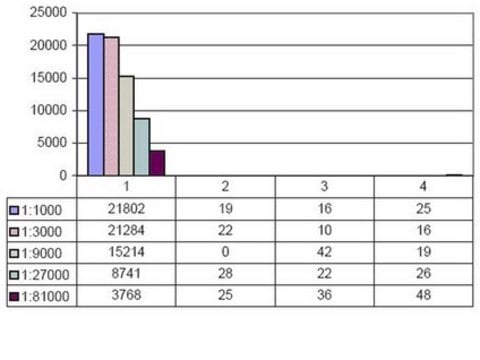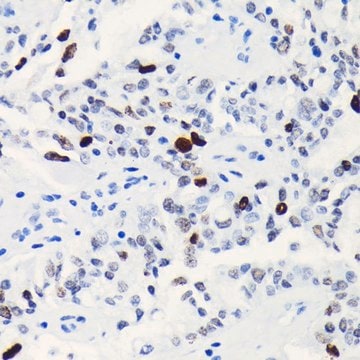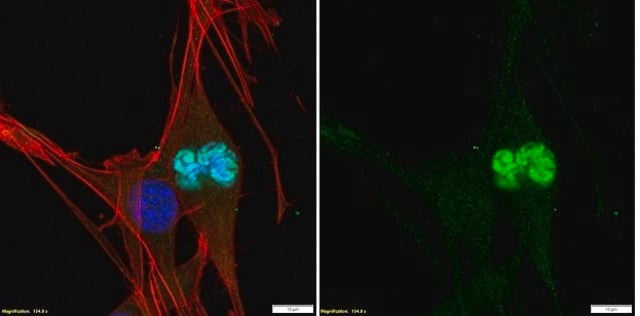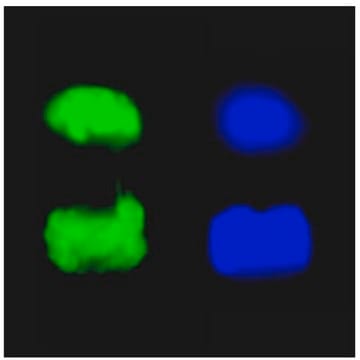04-817
Anti-phospho-Histone H3 (Ser10) Antibody, clone MC463, rabbit monoclonal
culture supernatant, clone MC463, Upstate®
Synonyme(s) :
H3 histone, family 3A, H3S10P, Histone H3 (phospho S10), H3 histone, family 3A, H3 histone, family 3B, H3 histone, family 3B (H3.3B)
About This Item
Produits recommandés
Source biologique
rabbit
Niveau de qualité
Forme d'anticorps
culture supernatant
Type de produit anticorps
primary antibodies
Clone
MC463, monoclonal
Espèces réactives
human
Fabricant/nom de marque
Upstate®
Technique(s)
ChIP: suitable (ChIP-seq)
dot blot: suitable
immunocytochemistry: suitable
immunofluorescence: suitable
multiplexing: suitable
western blot: suitable
Isotype
IgG
Numéro d'accès NCBI
Numéro d'accès UniProt
Conditions d'expédition
dry ice
Modification post-traductionnelle de la cible
phosphorylation (pSer10)
Informations sur le gène
human ... HIST1H3F(8968)
Description générale
Spécificité
Immunogène
Application
Epigenetics & Nuclear Function
Histones
A 1:2,000-1:4,000 dilution of this lot detected phosphorylated histone H3 in acid extracted proteins from mitotic HeLa cells (Catalog #17-306) treated with colcemid (lane 1) vs. untreated cells (lane 2) (Figure A).
Beadlyte Histone-Peptide Specificity Assay:
A 1:5,000 dilution of a previous lot was incubated with histone H3 peptides containing various modifications conjugated to Luminex microspheres. (Figure B). Only the peptide containing phospho-serine 10 was detected.
Immunofluorescence:
Representative image from a previous lot.
Positive chromosome immunostaining for mitotic HeLa cells and A431 cells.
Chromatin Immunoprecipitation:
A previous lot was shown to be suitable for ChIP by an independent laboratory.
Qualité
Description de la cible
Liaison
Forme physique
Stockage et stabilité
Handling Recommendations: Upon receipt, and prior to removing the cap, centrifuge the vial and gently mix the solution. Aliquot into microcentrifuge tubes and store at -20°C. Avoid repeated freeze/thaw cycles, which may damage IgG and affect product performance.
Remarque sur l'analyse
UV-treated 293 cell extracts, UV-treated HeLa cell extracts, breast cancer tissue, HEPG2 cell extracts
Informations légales
Clause de non-responsabilité
Not finding the right product?
Try our Outil de sélection de produits.
En option
Code de la classe de stockage
10 - Combustible liquids
Classe de danger pour l'eau (WGK)
WGK 2
Certificats d'analyse (COA)
Recherchez un Certificats d'analyse (COA) en saisissant le numéro de lot du produit. Les numéros de lot figurent sur l'étiquette du produit après les mots "Lot" ou "Batch".
Déjà en possession de ce produit ?
Retrouvez la documentation relative aux produits que vous avez récemment achetés dans la Bibliothèque de documents.
Notre équipe de scientifiques dispose d'une expérience dans tous les secteurs de la recherche, notamment en sciences de la vie, science des matériaux, synthèse chimique, chromatographie, analyse et dans de nombreux autres domaines..
Contacter notre Service technique








